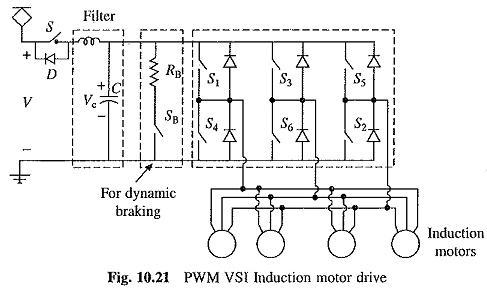PWM VSI Induction Motor Drive:
PWM VSI Induction Motor Drive for traction is shown in Fig. 10.21. A pulsewidth modulated voltage source inverter converts dc into variable frequency and variable voltage ac, which is then fed to induction motors.
Each motor coach of a suburban train may employ a single inverter feeding several squirrel-cage motors connected in parallel. The inverter switches S1 to S6 may consists of self-commutated devices such as GTO, power transistor or IGBT or a forced commutated thyristor. IGBT is the most suitable device for motor coaches.
A locomotive, because of high power rating will employ suitable number of voltage source inverters, with each inverter feeding a suitable number of squirrel-cage motors connected in parallel. GTOs are popular, although forced commutated thyristors have also been used in-the past.
Because of PWM VSI Induction Motor Drive, the drive has smooth acceleration. The regenerative braking is inherent in the sense that no additional equipment is required to achieve it. If inverter frequency is lowered to make synchronous speed less than the motor speed, the drive operation shifts from motoring to regenerative braking.
Whenever, a possibility exists that regenerated energy may not be fully absorbed by the source, a facility for dynamic braking is added by the incorporation of RB, SB, S and D. While regenerating if the source is not able to absorb all the regenerated energy, excess energy is absorbed by filter capacitor C and its voltage Vc rises. When Vc crosses a prescribed limit, S is opened to isolate the source from dc link of the inverter and SB is closed to initiate dynamic braking.
The PWM VSI Induction Motor Drive has following advantages:
- Smooth acceleration due to absence of low speed torque pulsations.
- Good adhesion due to fast dynamic response and absence of torque pulsations.
- Voltage source inverter is more suitable for multi-motor drives.
- Low weight, volume and cost.
- Simpler control and efficient operation.
- Regenerative braking capability
One major drawback of this drive is the possibility of a shoot through fault in the voltage source inverter. The inverter is designed carefully to prevent such a fault. Further, expensive fuses are used to protect the switches S1 to S6 against a shoot through fault.
